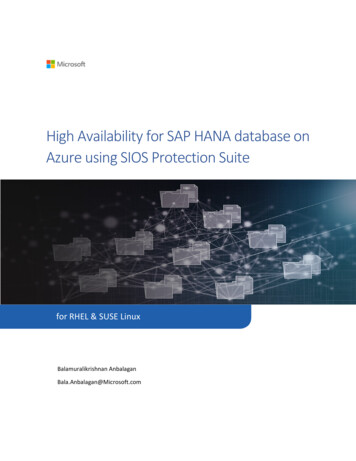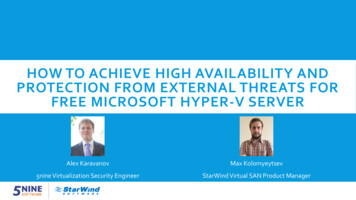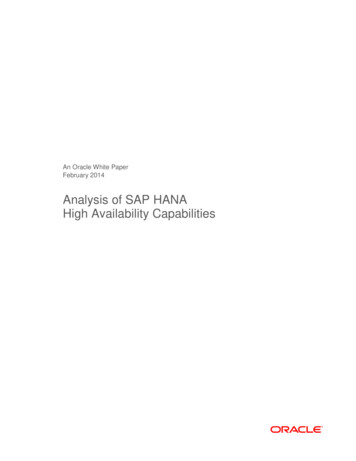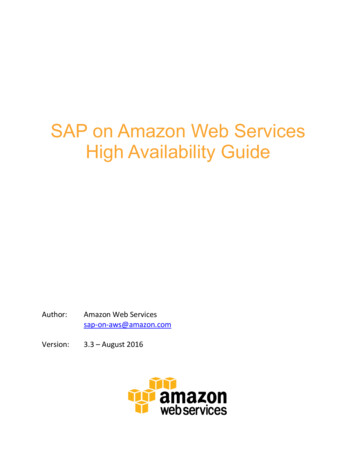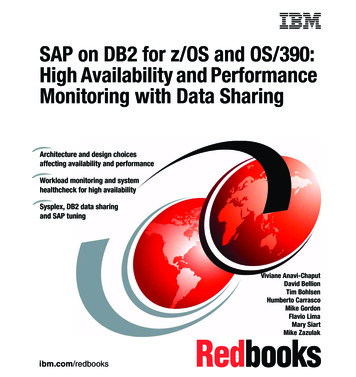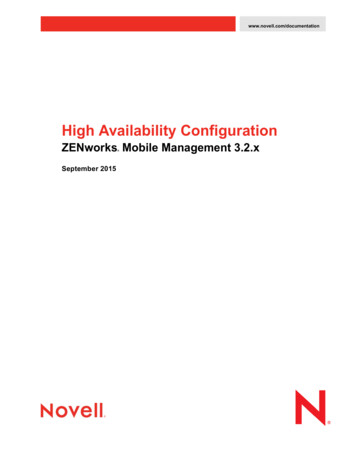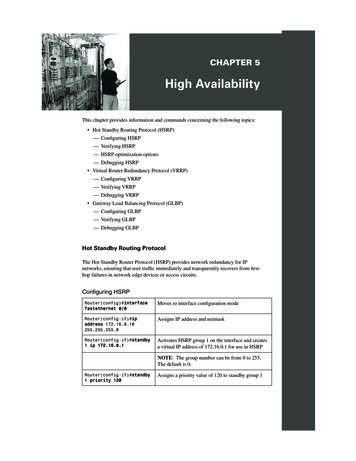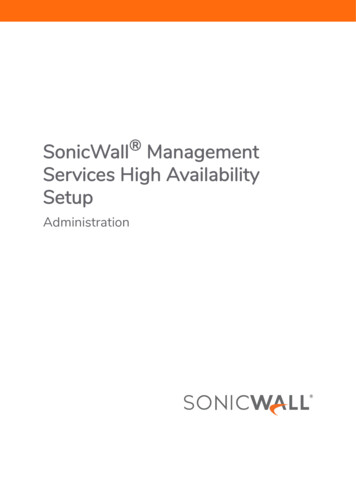
Transcription
SonicWall ManagementServices High AvailabilitySetupAdministration
1ContentsFirewall High Availability . . . . . . . . . . . . . . . . . . . . . . . . . . . . . . . . . . . . . . . . . . . . . . . . . . . . . . . . . . . . . 3About High Availability . . . . . . . . . . . . . . . . . . . . . . . . . . . . . . . . . . . . . . . . . . . . . . . . . . . . . . . . . . . . . . . . .What Is High Availability? . . . . . . . . . . . . . . . . . . . . . . . . . . . . . . . . . . . . . . . . . . . . . . . . . . . . . . . . . . .High Availability Modes . . . . . . . . . . . . . . . . . . . . . . . . . . . . . . . . . . . . . . . . . . . . . . . . . . . . . . . . . . . . .Crash Detection . . . . . . . . . . . . . . . . . . . . . . . . . . . . . . . . . . . . . . . . . . . . . . . . . . . . . . . . . . . . . . . . . . .Virtual MAC Address . . . . . . . . . . . . . . . . . . . . . . . . . . . . . . . . . . . . . . . . . . . . . . . . . . . . . . . . . . . . . . .Dynamic WAN Interfaces with PPPoE HA . . . . . . . . . . . . . . . . . . . . . . . . . . . . . . . . . . . . . . . . . . . . . . .Stateful Synchronization with DHCP . . . . . . . . . . . . . . . . . . . . . . . . . . . . . . . . . . . . . . . . . . . . . . . . . . .Stateful Synchronization with DNS Proxy . . . . . . . . . . . . . . . . . . . . . . . . . . . . . . . . . . . . . . . . . . . . . . .About HA Monitoring . . . . . . . . . . . . . . . . . . . . . . . . . . . . . . . . . . . . . . . . . . . . . . . . . . . . . . . . . . . . . .345667777About Active/Standby HA . . . . . . . . . . . . . . . . . . . . . . . . . . . . . . . . . . . . . . . . . . . . . . . . . . . . . . . . . . . . . . . 8Benefits of Active/Standby HA . . . . . . . . . . . . . . . . . . . . . . . . . . . . . . . . . . . . . . . . . . . . . . . . . . . . . . . 9How Active/Standby HA Works . . . . . . . . . . . . . . . . . . . . . . . . . . . . . . . . . . . . . . . . . . . . . . . . . . . . . . . 9About Stateful Synchronization . . . . . . . . . . . . . . . . . . . . . . . . . . . . . . . . . . . . . . . . . . . . . . . . . . . . . . . . . 10Benefits of Stateful Synchronization . . . . . . . . . . . . . . . . . . . . . . . . . . . . . . . . . . . . . . . . . . . . . . . . . . 10How Does Stateful Synchronization Work? . . . . . . . . . . . . . . . . . . . . . . . . . . . . . . . . . . . . . . . . . . . . 10Stateful Synchronization Example . . . . . . . . . . . . . . . . . . . . . . . . . . . . . . . . . . . . . . . . . . . . . . . . . . . 11About Active/Active DPI HA . . . . . . . . . . . . . . . . . . . . . . . . . . . . . . . . . . . . . . . . . . . . . . . . . . . . . . . . . . . . 12Benefits of Active/Active DPI HA . . . . . . . . . . . . . . . . . . . . . . . . . . . . . . . . . . . . . . . . . . . . . . . . . . . . 12Active/Standby and Active/Active DPI Prerequisites . . . . . . . . . . . . . . . . . . . . . . . . . . . . . . . . . . . . . . . . 12Supported Platforms for HA . . . . . . . . . . . . . . . . . . . . . . . . . . . . . . . . . . . . . . . . . . . . . . . . . . . . . . . . 13Physically Connecting your Firewalls . . . . . . . . . . . . . . . . . . . . . . . . . . . . . . . . . . . . . . . . . . . . . . . . . 13Connecting the Active/Active DPI Interfaces for Active/Active DPI . . . . . . . . . . . . . . . . . . . . . . . . . 13Registering and Associating Firewalls on MySonicWall . . . . . . . . . . . . . . . . . . . . . . . . . . . . . . . . . . 14Licensing High Availability Features . . . . . . . . . . . . . . . . . . . . . . . . . . . . . . . . . . . . . . . . . . . . . . . . . . 15Active/Active Clustering . . . . . . . . . . . . . . . . . . . . . . . . . . . . . . . . . . . . . . . . . . . . . . . . . . . . . . . . . . . . . . . 16About Active/Active Clustering . . . . . . . . . . . . . . . . . . . . . . . . . . . . . . . . . . . . . . . . . . . . . . . . . . . . . . 16Benefits of Active/Active Clustering . . . . . . . . . . . . . . . . . . . . . . . . . . . . . . . . . . . . . . . . . . . . . . . . . . 18How Does Active/Active Clustering Work? . . . . . . . . . . . . . . . . . . . . . . . . . . . . . . . . . . . . . . . . . . . . 19Configuring High Availability . . . . . . . . . . . . . . . . . . . . . . . . . . . . . . . . . . . . . . . . . . . . . . . . . . . . . . . . . 27Configuring Active/Standby High Availability Settings . . . . . . . . . . . . . . . . . . . . . . . . . . . . . . . . . . . . . . . 27Configuring HA with Dynamic WAN Interfaces . . . . . . . . . . . . . . . . . . . . . . . . . . . . . . . . . . . . . . . . . . . . . 29Configuring Active/Active DPI High Availability Settings . . . . . . . . . . . . . . . . . . . . . . . . . . . . . . . . . . . . . 29Configuring Advanced High Availability Settings . . . . . . . . . . . . . . . . . . . . . . . . . . . . . . . . . . . . . . . . . 31Monitoring High Availability . . . . . . . . . . . . . . . . . . . . . . . . . . . . . . . . . . . . . . . . . . . . . . . . . . . . . . . . . . 33Configuring High Availability Monitoring . . . . . . . . . . . . . . . . . . . . . . . . . . . . . . . . . . . . . . . . . . . . . . . . . . 33Verifying High Availability Status . . . . . . . . . . . . . . . . . . . . . . . . . . . . . . . . . . . . . . . . . . . . . . . . . . . . . . . . 34SonicWall Support . . . . . . . . . . . . . . . . . . . . . . . . . . . . . . . . . . . . . . . . . . . . . . . . . . . . . . . . . . . . . . . . . . 35About This Document . . . . . . . . . . . . . . . . . . . . . . . . . . . . . . . . . . . . . . . . . . . . . . . . . . . . . . . . . . . . . . . . . 36Management Services High Availability Setup AdministrationContents2
1Firewall High AvailabilityHigh Availability allows an administrator to specify a primary and secondary SonicWall appliance for theManagement Service. In the event that the connection to the primary device fails, connectivity transfers to thebackup device.In addition, the Management Service can utilize the same device pairing technology to implement differentforms of load balancing. Load balancing helps regulate the flow of network traffic by splitting that trafficbetween primary and secondary SonicWall devices.NOTE: High Availability is supported on TZ series and above firewalls. Active/Active Clustering is supportedon NSA 3600 and above firewalls.NOTE: High Availability is available at the appliance level; it cannot be configured at the group level.Topics: About High Availability About Active/Standby HA About Stateful Synchronization About Active/Active DPI HA Active/Standby and Active/Active DPI PrerequisitesAbout High AvailabilityTopics: What Is High Availability? High Availability Modes Crash Detection Virtual MAC Address Dynamic WAN Interfaces with PPPoE HA Stateful Synchronization with DHCP Stateful Synchronization with DNS Proxy About HA MonitoringManagement Services High Availability Setup AdministrationFirewall High Availability3
What Is High Availability?High Availability (HA) is a redundancy design that allows two identical SonicWall firewalls running theManagement Service to be configured to provide a reliable, continuous connection to the public Internet. OneSonicWall firewall is configured as the Primary unit, and an identical SonicWall firewall is configured as theSecondary unit. If the Primary firewall fails, the Secondary firewall takes over to secure a reliable connectionbetween the protected network and the Internet. Two firewalls configured in this way are also known as a HighAvailability Pair (HA Pair).High Availability provides a way to share SonicWall licenses between two SonicWall firewalls when one is actingas a high-availability system for the other. Both firewalls must be the same SonicWall model.To use this feature, you must register the SonicWall firewalls on MySonicWall as Associated Products.High Availability TerminologyActiveThe operative condition of a hardware unit. The Active identifier is a logical role that canbe assumed by either a Primary or Secondary hardware unit.FailoverThe actual process in which the Standby unit assumes the Active role following aqualified failure of the Active unit. Qualification of failure is achieved by variousconfigurable physical and logical monitoring facilities described in Configuring HighAvailability.HAHigh Availability: non-state, hardware failover capability.IDVInterface Disambiguation via VLAN.PoEPower over Ethernet is a technology that lets network cables carry electrical power.PPPPoint-to-point protocol that provides a standard method for transporting multi-protocoldiagrams over point-to-point links.PPPoEA method for transmitting PPP over ethernet.PPPoE HAHA PPPoE support function without State.PreemptApplies to a post-failover condition in which the Primary unit has failed, and theSecondary unit has assumed the Active role. Enabling Preempt causes the Primary unitto seize the Active role from the Secondary after the Primary has been restored to averified operational state.PrimaryThe principal hardware unit itself. The Primary identifier is a manual designation and isnot subject to conditional changes. Under normal operating conditions, the Primaryhardware unit operates in an Active role.The subordinate hardware unit itself. The Secondary identifier is a relational designationand is assumed by a unit when paired with a Primary unit. Under normal operatingSecondary (Backup)conditions, the Secondary unit operates in a Standby mode. Upon failure of the Primaryunit, the Secondary unit assumes the Active role.SHFState Hardware Failover, a Management Service feature that allows existing networkflows to remain active when the primary firewall fails and the backup firewall takes over.Standby (Idle)The passive condition of a hardware unit. The Standby identifier is a logical role that canbe assumed by either a Primary or Secondary hardware unit. The Standby unit assumesthe Active role upon a determinable failure of the Active unit.STPSpanning Tree Protocol.Management Services High Availability Setup AdministrationFirewall High Availability4
High Availability ModesHigh Availability has several operation modes, which can be selected on the High Availability Settings page: None—Selecting None activates a standard high availability configuration and hardware failoverfunctionality, with the option of enabling Stateful HA and Active/Active DPI. Active/Standby—Active/Standby mode provides basic high availability with the configuration of twoidentical firewalls as a High Availability Pair. The Active unit handles all traffic, while the Standby unitshares its configuration settings and can take over at any time to provide continuous networkconnectivity if the Active unit stops working.By default, Active/Standby mode is stateless, meaning that network connections and VPN tunnels mustbe re-established after a failover. To avoid this, Stateful Synchronization can be licensed and enabled withActive/Standby mode. In this Stateful HA mode, the dynamic state is continuously synchronized betweenthe Active and Standby units. When the Active unit encounters a fault condition, stateful failover occursas the Standby firewall takes over the Active role with no interruptions to the existing networkconnections.NOTE: Stateful HA is: Included on NSA 4600 and higher NSA platforms and SuperMassive Series platforms. Supported on the NSA 2600 and NSA 3600 platforms with a SonicOS Expanded License or aHigh Availability License. Supported on the TZ500 and higher TZ platforms with a Management Service ExpandedLicense or a High Availability (Stateful) License.For licensing information, see Registering and Associating Firewalls on MySonicWall and LicensingHigh Availability Features. Active/Active DPI—The Active/Active Deep Packet Inspection (DPI) mode can be used along with theActive/Standby mode. When Active/Active DPI mode is enabled, the processor intensive DPI services,such as Intrusion Prevention (IPS), Gateway Anti-Virus (GAV), and Anti-Spyware are processed on thestandby firewall, while other services, such as firewall, NAT, and other types of traffic are processed onthe Active firewall concurrently.NOTE: Active/Active DPI is: Included on the SM 9000 series platforms. Supported on the NSA 5600 and NSA 6600 platforms with a Management Service ExpandedLicense or a High Availability (Stateful) License.For licensing information, see Registering and Associating Firewalls on MySonicWall and LicensingHigh Availability Features. Active/Active Clustering—In this mode, multiple firewalls are grouped together as cluster nodes, withmultiple Active units processing traffic (as multiple gateways), doing DPI and sharing the network load.Each cluster node consists of two units acting as a Stateful HA pair. Active/Active Clustering providesStateful Failover support in addition to load-sharing. Optionally, each cluster node can also consist of asingle unit, in which case Stateful Failover and Active/Active DPI are not available.NOTE: Active/Active Clustering and Active/Active DPI Clustering are: Included on the SM 9000 series platforms Supported on NSA 5600 and NSA 6600 platforms only with the purchase of a ManagementService Expanded License.For licensing information, see Registering and Associating Firewalls on MySonicWall and LicensingHigh Availability Features.Management Services High Availability Setup AdministrationFirewall High Availability5
Active/Active DPI Clustering—This mode allows for the configuration of up to four HA cluster nodes forfailover and load sharing, where the nodes load balance the application of DPI security services tonetwork traffic. This mode can be enabled for additional performance gain, utilizing the standby units ineach cluster node.NOTE: Active/Active DPI Clustering is: Included on the SM 9000 series platforms Supported on NSA 3600 and above platforms only with the purchase of a ManagementService Expanded License.For licensing information, see Registering and Associating Firewalls on MySonicWall and LicensingHigh Availability Features.Crash DetectionThe HA feature has a thorough self-diagnostic mechanism for both the Active and Standby firewalls. The failoverto the standby unit occurs when critical services are affected, physical (or logical) link failure is detected onmonitored interfaces, or when the firewall loses power.The self-checking mechanism is managed by software diagnostics, which check the complete system integrity ofthe firewall. The diagnostics check internal system status, system process status, and network connectivity.There is a weighting mechanism on both sides to decide which side has better connectivity to avoid potentialfailover looping.Critical internal system processes such as NAT, VPN, and DHCP (among others) are checked in real time. Thefailing service is isolated as early as possible, and the failover mechanism repairs it automatically.Virtual MAC AddressThe Virtual MAC address allows the High Availability pair to share the same MAC address, which dramaticallyreduces convergence time following a failover. Convergence time is the amount of time it takes for the devices ina network to adapt their routing tables to the changes introduced by high availability.Without Virtual MAC enabled, the Active and Standby firewalls each have their own MAC addresses. Becausethe firewalls are using the same IP address, when a failover occurs, it breaks the mapping between the IPaddress and MAC address in the ARP cache of all clients and network resources. The Secondary firewall mustissue an ARP request, announcing the new MAC address/IP address pair. Until this ARP request propagatesthrough the network, traffic intended for the Primary firewall’s MAC address can be lost.The Virtual MAC address greatly simplifies this process by using the same MAC address for both the Primary andSecondary firewalls. When a failover occurs, all routes to and from the Primary firewall are still valid for theSecondary firewall. All clients and remote sites continue to use the same Virtual MAC address and IP addresswithout interruption.By default, this Virtual MAC address is provided by the SonicWall firmware and is different from the physicalMAC address of either the Primary or Secondary firewalls. This eliminates the possibility of configuration errorsand ensures the uniqueness of the Virtual MAC address, which prevents possible conflicts. Optionally, you canmanually configure the Virtual MAC address on the High Availability Monitoring page.The Virtual MAC setting is available even if Stateful High Availability is not licensed. When Virtual MAC isenabled, it is always used even if Stateful Synchronization is not enabled.Management Services High Availability Setup AdministrationFirewall High Availability6
Dynamic WAN Interfaces with PPPoE HANOTE: Dynamic WAN interfaces with PPPoE HA is not supported on the SuperMassive 9800. Only theDHCP Server dynamic WAN mode is supported.With the Management Service, PPPoE can be enabled on interfaces in non-stateful mode, HA Active/Standbymode. PPPoE HA provides HA where a Secondary firewall assumes connection to the PPPoE server when theActive firewall fails.NOTE: One WAN interface must be configured as PPPoE Unnumbered.After the Active unit connects to the PPPoE server, the firewall synchronizes the PPPoE session ID and servername to the Secondary unit.When the Active firewall fails, it terminates the PPPoE HA connection on the client side by timing out. TheSecondary firewall connects to the PPPoE server, terminates the original connection on the server side, andstarts a new PPPoE connection. All pre-existing network connections are rebuilt, the PPPoE sessions arere-established, and the PPP process is renegotiated.Stateful Synchronization with DHCPWith the Management Service, DHCP can now be enabled on interfaces in both Active/Standby (non-stateful)and Stateful Synchronization modes.Only the Active firewall can get a DHCP lease. The Active firewall synchronizes the DHCP IP address along withthe DNS and gateway addresses to the Secondary firewall. The DHCP client ID is also synchronized, allowing thisfeature to work even without enabling Virtual MAC.During a failover, the Active firewall releases the DHCP lease and, as it becomes the Active unit, the Secondaryfirewall renews the DHCP lease using the existing DHCP IP address and client ID. The IP address does not change,and network traffic, including VPN tunnel traffic, continues to pass.If the Active firewall does not have an IP address when failover occurs, the Secondary firewall starts a new DHCPdiscovery.Stateful Synchronization with DNS ProxyDNS Proxy supports stateful synchronization of DNS cache. When the DNS cache is added, deleted, or updateddynamically, it synchronizes to the idle firewall.About HA MonitoringOn the High Availability Monitoring page, you can configure both physical and logical interface monitoring: By enabling physical interface monitoring, you enable link detection for the designated HA interfaces.The link is sensed at the physical layer to determine link viability. Logical monitoring involves configuring the SonicWall to monitor a reliable device on one or more of theconnected networks.Failure to periodically communicate with the device by the Active unit in the HA Pair triggers a failover to theStandby unit. If neither unit in the HA Pair can connect to the device, no action is taken.Management Services High Availability Setup AdministrationFirewall High Availability7
The Primary and Secondary IP addresses configured on the High Availability Monitoring page can beconfigured on LAN or WAN interfaces, and are used for multiple purposes: As independent management addresses for each unit (supported on all physical interfaces) To allow synchronization of licenses between the Standby unit and the SonicWall licensing server As the source IP addresses for the probe pings sent out during logical monitoringConfiguring unique management IP addresses for both units in the H
forms of load balancing. Load balancing helps regulate the flow of network traffic by splitting that traffic between primary and secondary SonicWall devices. Topics: About High Availability About Active/Standby HA About Stateful Synchronization About Active/Active DPI HA Active/Standby and Active/Active DPI Prerequisites




